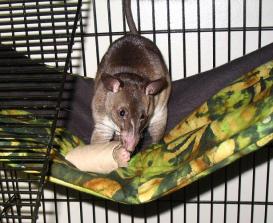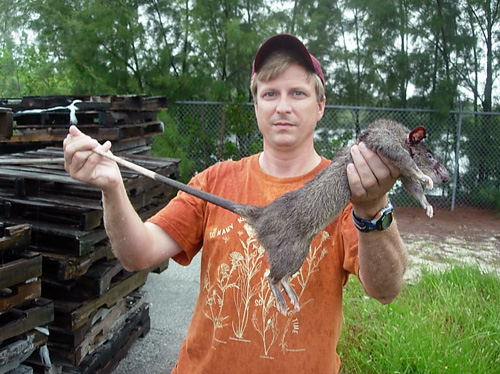Dogs have powerful noses; they can be trained to sniff out anything from land mines to cancer. However, they are not the only furry, four-legged creature that relies on a keen sense of smell. The Gambian pouched rat (Cricetomys gambianus, also known as the African giant pouched rat) is a large rodent (not technically a true rat) that relies heavily on its sense of smell.
What does this have to do with Tuberculosis? TB bacterium omit a Volatile Organic Compound (VOC), which can then be detected by smell. The rats are being utilized in countries that can’t afford state-of-the-art testing methods, which can cost more than 20 USD per sample and require the purchase of tens of thousands of dollars worth of equipment. TB disproportionately affects resource-poor nations; more than 95% of deaths due to TB occur in low- and middle-income countries.
After a non-profit called APOPO successfully trained the pouched rats to detect land mines, they turned to tuberculosis. The rats could potentially provide a reliable, cheap TB screening method in developing countries. Two studies explored the sensitivity (proportion of true positives, or samples noted as positive that were indeed positive) and specificity (proportion of true false tests, or samples marked as negative from people who were not sick) of the rats. Numbers ranged from 68.5% to 87.9% in regards to sensitivity and from 87.3% to 95.8% in regards to specificity. (Former numbers from Mahoney et.al., latter from Weetjens et.al.) For comparison, Mahoney et.al. reported that their control measure (sputum smear) had a sensitivity of 58.0% and a specificity of 97.3%.
The samples used are sputum samples. These are very easy to collect, as all the patient needs to do it cough up phlegm and spit it in a cup. The samples are then lined up under a platform with holes in it, and the rat walks across the platform. The rat is trained to pause for five seconds over a sample that smells positive for TB. (Don’t worry, the rats are trained using positive reinforcement. During training, if they pause over a TB sample, they get a piece of banana. If they pause over a non-positive TB sample, they don’t get a treat.) While findings are promising, continued studies are needed and are urged by lung disease specialists and by microbiolgists. These further studies are required before the rats can be trained by personel outside the organization. Protocols for the care, keeping, and training of the pouched rats need to be properly standardized. So far the rats are sucessful on a small scale, but for their training ans use to be scaled up these minutiae need to be determined.
Below: a relatively short (2 min 49 seconds) video clip from APOPO showing trained rats (called HEROrats) in action!
Why is this important?
Why are we adding another TB test to the long list of tests already available? There are microbiological assays (tests) for sputum, blood, tissues, and even pus. Simpler tests include skin tests and chest x-rays. Sputum spear microscopy, the most common technique in resource-poor countries, is very simple. The sample is stained with a dye that only adheres to the tuberculosis pathogen, and then a trained technician views the sample for pathogen. However, their are limitations for all of these tests. Assays can be cost-prohibitive, x-rays require equipment and a trained radiologist, and skin tests are hard to read and can fail to catch a new infection. Sputum spear microscopy is cheap and low-tech, but M. tuberculosis bacteria is not always present in the sample. With an average sensitivity that typically falls around 60%, that means that the test only catches a case 60% of the time. Gambian pouched rats have thus far shown to be reliable. An added benefit is that once they are trained, their cost is simply food and housing (as the video mentions, they work for peanuts) and they work faster than any human technician.
Better testing means that more illnesses will be caught sooner. TB is highly infectious, so the faster a case can be found, the fewer people that person will infect. Lower case numbers means that more a country’s scarce resources can go to treating TB. However, this points to what the rats don’t fix. With cheap (and sometimes furry) diagnostic methods, will we beat the scourge of TB? Probably not. Diagnostic methods do not solve the difficulty of properly treating TB. This is especially true in regards to multi- and extreme-drug resistant TB; the treatment of those cases requires extensive monitoring and the use of often expensive antibiotics. The HEROrats are a step in the right direction, but to effectively beat TB we need to treat and diagnose with rapid, thorough methods.


This is such a cool story, thanks for sharing. When I was in Mozambique I met some people working with rats training to detect landmines. For all their negative roles in some of our infectious diseases, these are still pretty amazing animals.